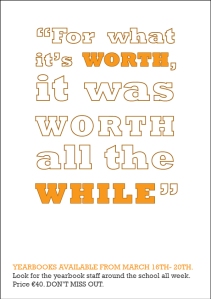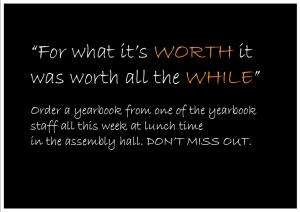10 Tips to make your yearbook presentation great.
1. Make it special.
2. Make it meaningful.
3. Make it relevant to the year.
4. Have a presentation ceremony.
5. Think of the yearbook as a product.
6. Add something else to it.
7. Personalise each book.
8. Be environmentally friendly.
9. Use social media.
10. Get publicity.
Some ideas…
1. Make your yearbook something that people will love to receive.
Present your yearbook in a presentation box with little gifts/sweets. You could add memorabilia of the year to your box.
2. Present the yearbook in a school memories folder.
This could include a copy of the school play programme, a copy of the final year exam papers, a contact list for all of the students. Use your imagination and make it meaningful.
3. Add a music CD.
Maybe your school has a school band or an excellent music class or choir. As a part of your presentation, you could produce a showcase CD of original school music. You could also use a CD with the best of the year chart music to bring back great memories of the year- beware of copyright laws if you choose to use copyrighted music- you may need to ask permission and credit the artists.
4. Add a multimedia CD/DVD.
You could include a DVD with the photo files from the yearbook or the photos that haven’t made it. You could use a simple programme such as Windows Movie Maker to make theses photos into a slide show DVD that the students can watch at home on their TV or computer. You could alsoask students to submit their video files from their cameras with their yearbook submissions and add these to a special edition yearbook DVD.
5. Package your yearbook.
You could package your yearbook like a product. There are many cheap ways to make a product look special. Use your imagination or ask someone who has an interest in crafts for some ideas- have a look in your local craft shop to see what they have- pretty papers, beads, ribbons, etc.
Idea: use the plastic sealable bags used by photographers (available in every good art supply store)
Get a bag that fits the yearbook’s width.
Place the yearbook inside- you can add something extra to the bag if you wish.
Fold the bag neatly at the back and seal.
Tape a paper ribbon bow to the top left corner at the front.
Add a sticker to the back of the package with the name of the student.
6. Personalise it.
Try to make your book personal to each student that receives it. You could do this in many ways.
Idea: make a book jacket that is individual for each recipient.
Have a general grid but feature the student’s yearbook photo as the main image on the personal book jacket. Remember that it is more expensive to get different designs printed by your printer than many of the same, you could ask about using the printing facilities at the school to do this yourself or you could print a general jacket with your printer and stick on the personalised image.
Idea: have a scheduled book signing.
Label each book at the signing and allow friends to sign each other’s book and it will be filled with personal messages when the student receives it. Make sure that if you do something like this that students are aware that if any inappropriate messages are included, the cost of new books will be added to the price each person pays.
Another way is to design a sticker with the student’s name to add to the packaging.
7. Have a presentation ceremony.
Use the ceremony to get people excited about the yearbook. Invite parents, teachers and students. Make it fun by having it as an awards ceremony. Collect nominations before the ceremony and annouce the winners on the night. The finalists and winners can be printed in the yearbook.
8. Be environmentally friendly.
Think of ways to be good to your environment when producing your yearbook. This can be using local printers and suppliers or publishing your yearbook onlineas a website or in a pdf format which is emailed or put onto a CD for each student.
9. Use social media.
Set up a fan page on facebook and get followers on twitter. You can use these platforms to show sneak previews or add photos that will appear in the yearbook. Tag people to let them know they will be featured. You can also add videos of production or just update your status so people know how it’s going. You can take orders online or through a dedicated email address. If you supply these links with your yearbook, extra copies can be ordered orpeople can comment on the final product.
10. Get publicity.
Use your local press to get some publicity for your yearbook. Ask someone who is involved and who is good at writing to write an article for the local press. Good news stories are always welcome. Perhaps students as entrepreneurs would be an angle to use. Be creative and ask everyone- someone might just say yes. Use this publicity to promote your yearbook within the school and beyond its borders.
Tags: education, environmentally friendly yearbooks, great yearbook presentation, packaging, presentation, professional presentation, professional yearbooks, school, school yearbooks, teaching, tips, ways to make yearbook special, yearbook ceremony, yearbook design, yearbook ideas, yearbook publicity, yearbook social media, yearbook tips, yearbooks







